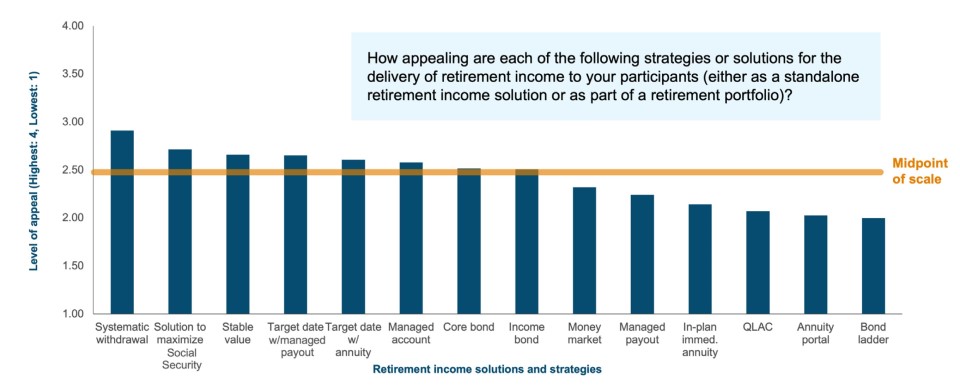April 2021 / RETIREMENT INSIGHTS
New Outlook on Income
A framework for evaluating retirement income solutions in defined contribution plans
Key Insights
- The pursuit of retirement income solutions for defined contribution plans has been underway for the better part of the last decade, yet adoption remains low.
- We believe uptake of retirement income solutions often stalls because the retirement industry leads with product and deemphasizes fundamental needs and objectives.
- This paper offers insights and a conceptual evaluation framework to help plan sponsors assess retirement income solutions in a more strategic and informed way.
"By failing to prepare, you are preparing to fail.”
― Benjamin Franklin
Like anything else, preparation is key to progress. In fact, having a plan makes action achievable. Without a plan, Benjamin Franklin’s words ring true: Failure may be inevitable. This wisdom carries over to the long and winding road of bringing retirement income solutions to defined contribution (DC) plans and participants.
Here, too, we believe preparation is almost always required to make progress. This retirement income journey has been underway for the better part of a decade, yet adoption of retirement income solutions remains low.
However, this should not be a complete surprise. The shift in mindset required to evolve a DC plan from a savings vehicle to a more full-fledged retirement solution is not easy work. It typically requires plan decision-makers to adapt their thinking and alter long-established processes. Adding difficulty, false assumptions about retirement objectives can get in the way of making real progress.
On the bright side, T. Rowe Price research with DC consultants confirms that retirement income is at the top of the list for discussion with their plan sponsor clients as we all recover from the “pandemic pause” of 2020. This suggests that retirement income conversations are again poised to take center stage.
In this paper, we pick up where we left off in our It’s Time to Get Serious About Retirement Income Solutions paper1 and bring focus to inputs that can inform the retirement income pursuit and outline an evaluation framework to help sponsors navigate the complex retirement income landscape. This work is designed to help sponsors identify retirement income solutions that merit further exploration and rule out less suitable approaches.
Fig. 1: Lackluster Appeal
T. Rowe Price Retirement Income Plan Sponsor Survey, 2020.

Source: T. Rowe Price Retirement Income Plan Sponsor Survey, 2020. Includes responses from 211 DC plan sponsors and conducted with Pensions & Investments Content Solutions Group and Signet Research. Not all survey respondents completed all survey questions.
Replacing False Assumptions With Insight
Through our research with plan sponsors, participants, and DC investment consultants, we have identified anchor points that complicate the process of bringing effective retirement income solutions to participants. We can clear the way for progress by resetting some of these false assumptions with deeper insight.
Insight #1: Product-Led Discussions About Retirement Income Often Come Up Short
In recent research with DC investment consultants, we measured relatively slow progress in bringing retirement income solutions to DC plans. On average, only 21% of consultants’ plan sponsor clients currently offer retirement income solutions. Further research with plan sponsors echoes this finding. Across a range of potential retirement income offerings, plan sponsors reported those solutions as only modestly appealing, as illustrated in Figure 1.
However, before we jump to the conclusion that providers of retirement income solutions have simply failed to find the necessary “silver bullet” and that more product innovation is needed, let’s first reconsider the common product-led approach.
The retirement industry can be quick to begin conversations with a product and work backward to determine what problem the product can solve. While innovation is necessary to develop effective retirement income solutions, we believe “product” should rarely be the first step in a retirement income conversation between solution provider and plan sponsor.
Ultimately, it may be an issue of “the tail wagging the dog.” Product-led decision-making leads plan sponsors and fiduciaries to try to fit participant needs onto what a solution can provide. However, we believe a better process should first identify the intended objectives of plans and their participants and only then determine which solutions best address those needs.
Insight #2: The Retirement Income Puzzle Doesn’t Need to Be Solved All at Once
Many industry insiders have rallied behind the idea that providing a suite of solutions—what is often referred to as a “retirement tier”—is the most sensible path forward. On its surface, this is an elegant approach that provides retiring participants with building blocks to assemble portfolios suited to their unique circumstances and bypassing the false presumption that a single offering will be appropriate for all.
In our research, 94% of DC consultants agreed that a suite of income solutions is preferred to a single retirement income offering. However, while many consider it sensible, DC consultants also report that only 13% of their plan sponsor clients currently provide or are planning to provide a retirement tier.2 Ultimately, the graceful simplicity of the tier approach may often succumb to the complexity of having to decide what a retirement tier should include and how it should be delivered.
However, by understanding that a suite of solutions doesn’t need to be constructed all at once, we can simplify the process and begin to make progress. In fact, an iterative and intentionally staggered process—focused on short-term, intermediate-term, and long-term goals—enhances the flexibility of a tier-based approach. In fact, plans frequently already offer some of the building blocks that would make up an effective retirement tier. Phasing in additional solutions to fill gaps can power the construction of the retirement tier, step by step.
One symptom of the product-led disconnect is that new solutions often fail to find traction. Over the years, many retirement income solutions have been launched with expectations of high demand and use, only to be paused or decommissioned entirely due to low uptake. While these product launches are well-intended, innovation in DC is hard work and requires multiple layers of consideration. By starting with clear insight on needs and objectives rather than what a specific product is prepared to deliver, we can steer the evaluation process to better outcomes.
Insight #3: Annuities Don’t Need to Have the Starring Role
Viewed at a high level, it can appear as if the primary objective of financing life in retirement is simply to not run out of money during one’s lifetime. If addressing duration risk is the primary objective of a retirement income solution, then income annuities and the guaranteed lifetime income they typically provide seem to be the best and most obvious answer: a perfect tool for the job.
However, we previously highlighted the lackluster appeal of retirement income solutions in the eyes of plan sponsors, and in that list, annuity-based solutions were well represented at the back of the pack. If annuity-based solutions fail to inspire, it’s not due to lack of legislative support. In December of 2019, the SECURE Act included several provisions that could encourage plan sponsors to adopt lifetime retirement income features. Yet, in November 2020—nearly a year after the passage of the SECURE Act–61% of plan sponsors reported that the act failed to motivate them to consider retirement income solutions. Granted, 2020 was an exceptional year during which many plan sponsors reoriented their strategic initiatives to address pandemic-related matters, but legislative and regulatory developments often open doors to innovation, so the resulting disinterest is puzzling. Or is it?
Guaranteed income solutions directly address the risk of outliving retirement savings, but addressing duration risk is only one of many objectives participants may want to achieve. In T. Rowe Price-sponsored focus groups made up of near-retirement participants, we encountered strong sentiments against annuitization. Ultimately, to the extent that income guarantees threaten to interfere with satisfying other needs—like continued growth of retirement assets, ability to adjust income level, or control of investment allocation—participants often choose to avoid income guarantees altogether.
Nonetheless, we should not let this dissuade us from working toward supporting income in retirement. At T. Rowe Price, we firmly believe that guaranteed income solutions can play an important part in financing life in retirement, but a collection of retirement income solutions should be flexible enough to address a wider and more varied set of income needs and objectives. Often, non-guaranteed income solutions can be effective by simply helping to translate retirement savings to a regular stream of income.
IMPORTANT INFORMATION
This material is being furnished for general informational purposes only. The material does not constitute or undertake to give advice of any nature, including fiduciary investment advice, and prospective investors are recommended to seek independent legal, financial and tax advice before making any investment decision. T. Rowe Price group of companies including T. Rowe Price Associates, Inc. and/or its affiliates receive revenue from T. Rowe Price investment products and services. Past performance is not a reliable indicator of future performance. The value of an investment and any income from it can go down as well as up. Investors may get back less than the amount invested.
The material does not constitute a distribution, an offer, an invitation, a personal or general recommendation or solicitation to sell or buy any securities in any jurisdiction or to conduct any particular investment activity. The material has not been reviewed by any regulatory authority in any jurisdiction.
Information and opinions presented have been obtained or derived from sources believed to be reliable and current; however, we cannot guarantee the sources' accuracy or completeness. There is no guarantee that any forecasts made will come to pass. The views contained herein are as of the date noted on the material and are subject to change without notice; these views may differ from those of other T. Rowe Price group companies and/or associates. Under no circumstances should the material, in whole or in part, be copied or redistributed without consent from T. Rowe Price.
The material is not intended for use by persons in jurisdictions which prohibit or restrict the distribution of the material and in certain countries the material is provided upon specific request.
It is not intended for distribution to retail investors in any jurisdiction.
This material was prepared for use in the United States for U.S.-based plan sponsors, consultants, and advisors, and the material reflects the current retirement environment in the U.S. It is also available to Canada-based plan sponsors, consultants and advisors for reference. There are many differences between the two nations’ retirement plan offerings and structures. Therefore, from a Canadian perspective, this material is offered for educational purposes only and does not constitute a solicitation or offer of any product or service.
USA—Issued in the USA by T. Rowe Price Associates, Inc., 100 East Pratt Street, Baltimore, MD, 21202, which is regulated by the U.S. Securities and Exchange Commission. For Institutional Investors only.
© 2021 T. Rowe Price. All rights reserved. T. ROWE PRICE, INVEST WITH CONFIDENCE, and the bighorn sheep design are, collectively and/or apart, trademarks or registered trademarks of T. Rowe Price Group, Inc.
March 2021 / RETIREMENT INSIGHTS
